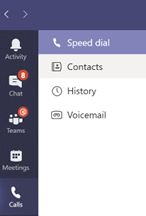 Teams is more than just a replacement for Skype for Business on your PC, it’s also a consummate mobile app that functionally eclipses its predecessor in many ways, and even its desktop sibling in some. If you haven’t installed the Teams mobile app on your phone, go and get it (and other Office apps) for Googly Devices or Fruity Phones. The remaining Windows Phone users can follow the setup link here, though be prepared for disappointment. Teams is more than just a replacement for Skype for Business on your PC, it’s also a consummate mobile app that functionally eclipses its predecessor in many ways, and even its desktop sibling in some. If you haven’t installed the Teams mobile app on your phone, go and get it (and other Office apps) for Googly Devices or Fruity Phones. The remaining Windows Phone users can follow the setup link here, though be prepared for disappointment.
 The “Calls” tab on the mobile version on the app is more usable in some senses than Calls on the PC version of Teams is, since it exposes phone numbers more easily. On the desktop Teams app, if you want to use the service to call an existing contact via the POTS, the actual phone number you use can at times be somewhat obscured. The “Calls” tab on the mobile version on the app is more usable in some senses than Calls on the PC version of Teams is, since it exposes phone numbers more easily. On the desktop Teams app, if you want to use the service to call an existing contact via the POTS, the actual phone number you use can at times be somewhat obscured.
 On the PC app, for example, if you look at History, you’ll often seen a list of people but it’s not clear which number they called from (or you called them on) , and you’ll need to use the Contacts list within Calls to be able to direct a new call to a specific number. On the PC app, for example, if you look at History, you’ll often seen a list of people but it’s not clear which number they called from (or you called them on) , and you’ll need to use the Contacts list within Calls to be able to direct a new call to a specific number.
In the Teams mobile app, if you look at the Calls tab, under History, tap on a line and then the card to the right side of the list of icons, you’ll get a contact card and the ability to respond back – using Teams – to any one of the listed phone numbers.
 Under Settings, you also get a bit more direct control over do not disturb functionality with quiet hours and days. Under Settings, you also get a bit more direct control over do not disturb functionality with quiet hours and days.
Finally, one of the great new functions in Teams mobile is the building-in of  Org Chart functions, so you can browse the global address list hierarchy while on the move (assuming such info is populated in the directory). Org Chart functions, so you can browse the global address list hierarchy while on the move (assuming such info is populated in the directory).
Just search for a contact’s name, and their organisational tree is only a tap away.
For more tips on using Teams Mobile, see here. |




